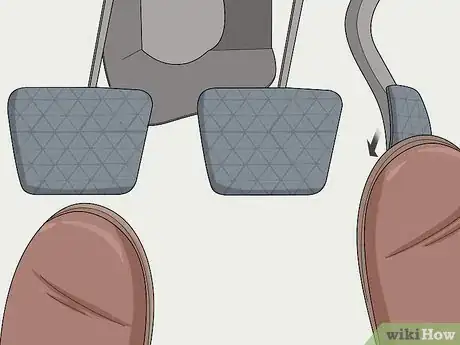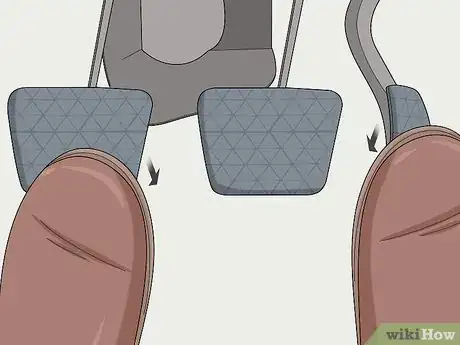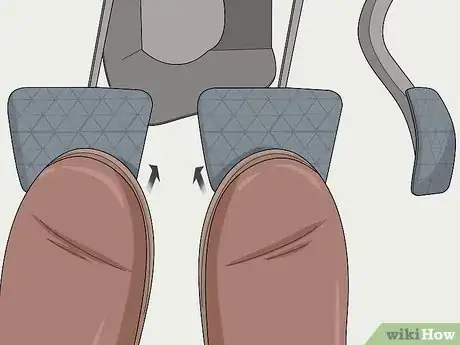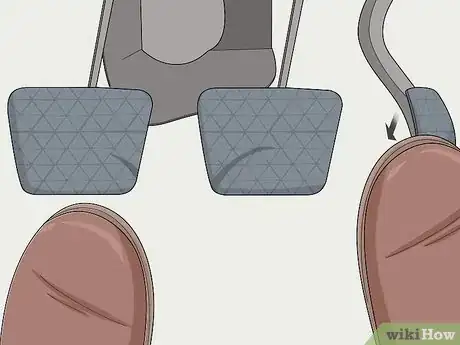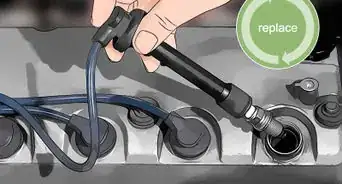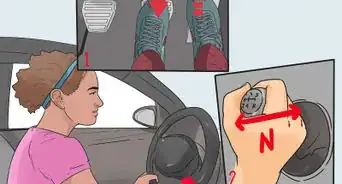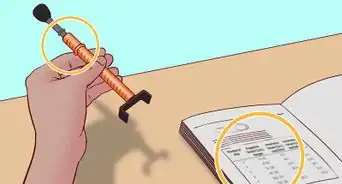This article was co-authored by Ibrahim Onerli and by wikiHow staff writer, Eric McClure. Ibrahim Onerli is a Driving Instructor and the Manager of Revolution Driving School in New York City. His mission is to make the world a better place by teaching safe driving. Ibrahim trains and manages a team of over eight driving instructors. He specializes in teaching defensive driving and stick shift driving.
wikiHow marks an article as reader-approved once it receives enough positive feedback. In this case, 90% of readers who voted found the article helpful, earning it our reader-approved status.
This article has been viewed 450,303 times.
If you drive a car with a manual transmission, getting started on a hill can be a little intimidating. Fortunately, it’s pretty easy to start on a hill once you’ve practiced a few times, and you can always pull the handbrake to stop your car if you feel like you’re stalling. To start going uphill from a stopped position, you can either shuffle between the brake and the accelerator while releasing the clutch or press the accelerator down while lowering the handbrake. You can also get started going downhill by releasing the brakes and clutch before moving your foot to the accelerator. With a little practice, anyone can learn to start a manual car on a hill in no time!
Steps
Shuffling Your Pedals
-
1Hold the brake pedal down with your right foot and the clutch with your left. Use both of your feet to press the clutch and the brake pedal down. Keep them both held down all the way.[1]
- In a manual car, the clutch is the pedal all the way on the left. The brake is in the middle and the accelerator is on the right.
- Even if you’re driving a car where the wheel is on the right side, the order of the pedals is usually the same.
- The clutch is the pedal that transfers power from your engine to the wheels. Holding it down keeps your wheels from spinning while your engine is on. Releasing it completely transfers all of the power from the engine to the wheels.
-
2Turn your car on and shift the gear into 1st. Turn your car on by turning the key in the ignition. Shift the car from neutral into 1st gear. You may feel the car try to slide back as you start it, but it will stop immediately, so don’t worry. Do not take your feet off of the clutch and brake as you’re starting.[2]Advertisement
-
3Raise the clutch slowly while shifting your foot to the accelerator. When you’re ready to start moving, pull the handbrake down. Quickly shift your right foot from the brake to the accelerator. Begin releasing the clutch at the same time that you’re pressing down on the accelerator to start moving.[3]
- If you start rolling backwards, press the foot brake and pull the handbrake. Start again. This can take some practice to get used to!
- Releasing the clutch too quickly will cause the car to stall.[4]
Tip: In the amount of time that it takes for you to move your foot from the brake to the accelerator, your car will rock backwards a little. Do this as quickly as possible to ensure that you don’t start rolling back.
-
4Press the accelerator down and fully release the clutch. As you press the accelerator down, release the clutch completely to get up to speed. You may notice the clutch “biting” or kicking back as you press the accelerator. This is normal, and is an indicator that you’re able to release it and control the car with your accelerator.[5]
- Biting refers to the friction you feel in the clutch when you’re accelerating the car. As you rev the engine up, the clutch is trying to mitigate the speed of the wheels, causing some friction in the pedal.
Using the Handbrake
-
1Pull the handbrake up while pressing the clutch down. Press the clutch down with your left foot. Press the button on the top of the handbrake to release it and pull the handbrake all the way up to its vertical position. Keep the clutch held down all the way while doing this.[6]
- This method is a little easier if you struggle shuffling your foot quickly from the brake to the accelerator. It’s basically the same as the first method, except you’re using the handbrake instead of the foot brake.
-
2Turn the car on and shift into 1st gear. Turn the key in the ignition to start the car. Do not shift your feet or move the handbrake while doing this. Shift into 1st gear.[7]
-
3Apply gas with your right foot while releasing the clutch. Slowly apply pressure to the accelerator while releasing the clutch. When you feel the clutch biting, or kicking back, you will know that your vehicle is trying to move forward.[8]
Tip: If you feel the car stalling, pull the handbrake to the vertical position to hold your car in place and try again. This can take a little practice to get used to, so don’t worry if it doesn’t feel natural at first!
-
4Release the handbrake at the same time as the clutch. Once the clutch is biting, press the button on the handbrake down. Move it forward at the same time as you’re pressing the accelerator down to release the brake and move the car forward.[9]
- Essentially, you’re releasing the handbrake and clutch at the same time that you’re accelerating. There may be some discrepancy between the clutch and the handbrake if you’re on a really steep incline.
Going Downhill
-
1Hold the brake and clutch down with both feet. If you’re starting out on a hill facing down, start by holding the clutch and footbrake down with both of your feet. Keep the clutch and brake held all the way down.[10]
- Keep your handbrake set in the vertical position while you’re doing this.
-
2Start the car and shift into 1st gear. With your car in neutral, turn the key in the ignition to start the car. Move the shifter into 1st gear. Do not move your feet off of the clutch or brake while doing this.[11]
-
3Release the handbrake slowly and grip the steering wheel. Put your hand on the steering wheel and use your other hand to press the button on the handbrake down. Slowly release the handbrake to release your car’s wheels from the locked position.[12]
- Your car may slowly drift forward while you’re releasing the handbrake, so do this slowly to monitor your speed.
-
4Release the foot brake and clutch at the same time, slowly. After you’ve released the handbrake, lift your feet slowly off of the foot brake and the clutch. Your car will start rolling forward down the hill. Use your hand to steer the car down the hill.[13]
- Once you get used to doing this, you can release the clutch, foot brake, and handbrake at the same time.
Tip: If you ever have a problem with your car starting or breaking down, you can do this in neutral to roll your car downhill a little and pull it over to the curb.
-
5Use the accelerator to bring the car up to your desired speed. With your clutch and both brakes released, shift your right foot to the accelerator and use it to control your car’s speed. If you need to slow down, use the brake and clutch to cut back on speed.[14]
Community Q&A
-
QuestionWhat do I do if a car suddenly stops infront of my car?
 Community AnswerEmergency stop immediately. Full brake and clutch on and sound your horn at the same time to make everyone aware of the situation, especially those behind you.
Community AnswerEmergency stop immediately. Full brake and clutch on and sound your horn at the same time to make everyone aware of the situation, especially those behind you. -
QuestionHow do I park on a hill with a manual transmission?
 Community AnswerShift it back into a gear once the vehicle is off and put your handbrake on.
Community AnswerShift it back into a gear once the vehicle is off and put your handbrake on. -
QuestionHow do I drive downhill?
 Community AnswerObtain your clutch control and press the brakes slowly to reduces speed gradually, depending on the slope of the hill.
Community AnswerObtain your clutch control and press the brakes slowly to reduces speed gradually, depending on the slope of the hill.
References
- ↑ https://www.autoblog.com/2016/07/26/how-to-get-started-on-a-hill-when-driving-a-manual-transmission/
- ↑ https://www.autoblog.com/2016/07/26/how-to-get-started-on-a-hill-when-driving-a-manual-transmission/
- ↑ https://www.autoblog.com/2016/07/26/how-to-get-started-on-a-hill-when-driving-a-manual-transmission/
- ↑ Ibrahim Onerli. Driving Instructor. Expert Interview. 18 November 2019.
- ↑ https://www.popularmechanics.com/cars/a28461/how-to-drive-stick-manual-transmission/
- ↑ https://drive.govt.nz/get-your-restricted/parking-turning-around-and-hills/hill-driving-manual/
- ↑ https://www.popularmechanics.com/cars/a28461/how-to-drive-stick-manual-transmission/
- ↑ https://www.popularmechanics.com/cars/a28461/how-to-drive-stick-manual-transmission/
- ↑ https://www.autoblog.com/2016/07/26/how-to-get-started-on-a-hill-when-driving-a-manual-transmission/
- ↑ https://drive.govt.nz/get-your-restricted/parking-turning-around-and-hills/hill-driving-manual/
- ↑ https://drive.govt.nz/get-your-restricted/parking-turning-around-and-hills/hill-driving-manual/
- ↑ https://drive.govt.nz/get-your-restricted/parking-turning-around-and-hills/hill-driving-manual/
- ↑ https://drive.govt.nz/get-your-restricted/parking-turning-around-and-hills/hill-driving-manual/
- ↑ https://drive.govt.nz/get-your-restricted/parking-turning-around-and-hills/hill-driving-manual/
About This Article
To get started on a hill in a manual car, start with your left foot pressing down the clutch and your right foot on the brake. When you’re ready to move, bring the clutch up until you feel it bite. While holding the car on the biting point, take your right foot off the brake and press the gas lever. Make sure you give it about 50 percent more gas than normal, since you’ll need more power to move the car uphill. If your handbrake is on, release it at this point. Then, slowly ease off the clutch while adding more gas to get moving. For more tips, including how to use the heel-toe technique when doing a hill start, read on!




